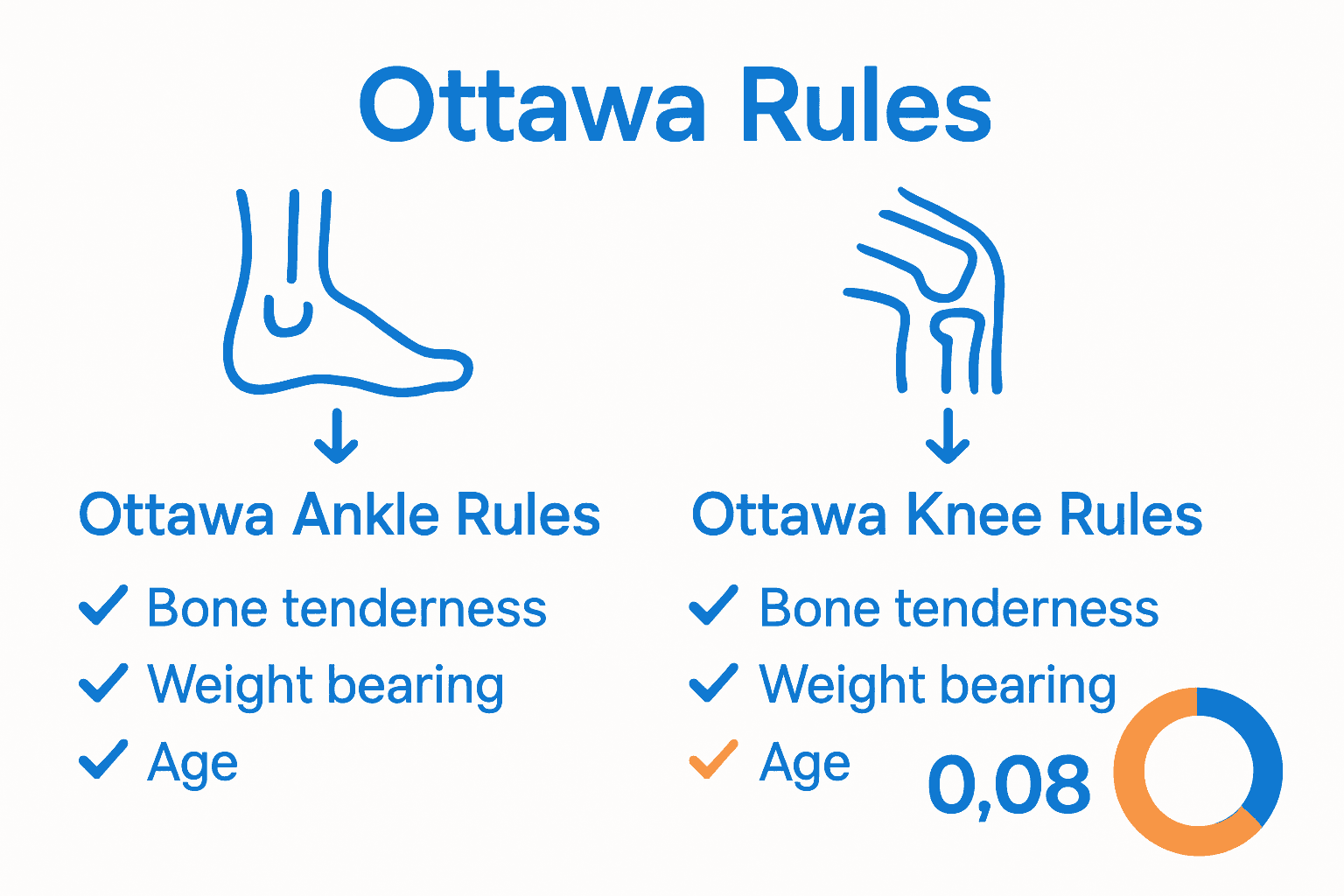What Is Ottawa Technique? Complete Guide
- 4 hours ago
- 7 min read

Most emergency departments face the same challenge: deciding quickly if an injured patient actually needs an X-ray. The Ottawa Technique has reshaped this process for clinicians worldwide, offering standardized rules that reduce unnecessary imaging without missing critical fractures. In fact, research shows a pooled negative likelihood ratio of just 0.08 for missing serious injuries. Discover how these evidence-based guidelines streamline care and help both patients and health systems avoid needless risks and costs.
Table of Contents
Key Takeaways
Definition and Purpose of Ottawa Technique
The Ottawa Technique is a groundbreaking clinical decision-making tool specifically designed to help medical professionals assess the need for radiographic imaging in acute musculoskeletal injuries. Developed by Dr. Ian Stiell and colleagues in Ottawa, Canada, this innovative approach provides a systematic method for determining when medical imaging is truly necessary.
According to cihr, the Ottawa Rules have become the standard of care worldwide, recognized for their remarkable ability to ensure patients with potential fractures receive appropriate diagnostic imaging while simultaneously reducing unnecessary medical procedures. The technique’s primary purpose is to streamline clinical assessment, minimize unnecessary radiation exposure, and optimize healthcare resource utilization.
The core principles of the Ottawa Technique involve a structured set of clinical guidelines that help healthcare providers make rapid, evidence-based decisions. These guidelines focus on specific anatomical assessment criteria that indicate when an x-ray or additional imaging might be required. Key diagnostic markers include:
Presence of bone tenderness at specific anatomical points
Patient’s ability to bear weight immediately after injury
Location and characteristics of pain and swelling
Mechanism and severity of the initial traumatic event
By implementing these precise assessment criteria, clinicians can quickly determine whether a patient requires further diagnostic investigation. cjen highlights that this approach not only reduces healthcare costs but also decreases patient exposure to unnecessary medical radiation, making it a significant advancement in clinical assessment protocols.
While initially developed for ankle and foot injuries, the Ottawa Technique’s principles have since been adapted and applied across various musculoskeletal assessment contexts, demonstrating its versatility and evidence-based approach to clinical decision-making.
Variations: Ankle, Knee Decision Rules
The Ottawa Technique extends beyond a single diagnostic approach, offering specialized decision rules for different musculoskeletal injury assessments. Two primary variations have emerged as critical tools in clinical practice: the Ottawa Ankle Rules and the Ottawa Knee Rules.
en describes the Ottawa Ankle Rules as precise guidelines enabling clinicians to determine whether a patient with foot or ankle pain requires X-ray imaging to diagnose potential fractures. These rules are strategically designed to minimize unnecessary radiographic procedures while ensuring critical injuries receive appropriate diagnostic attention.
Ottawa Ankle Rules
The Ottawa Ankle Rules focus on specific diagnostic criteria for ankle and foot injuries, including:
Bone tenderness at specific ankle or foot locations
Patient’s inability to bear weight immediately after injury
Pain in critical anatomical zones that suggest potential fracture
Inability to walk four steps in the emergency department
Ottawa Knee Rules
Similarly, en outlines the Ottawa Knee Rules as a systematic approach to determine when knee X-rays are medically necessary. These guidelines help physicians identify cases requiring imaging by considering:
Patient’s age and injury mechanism
Specific physical examination findings
Presence of bone tenderness at particular knee joint locations
Patient’s ability to flex and bear weight
Both rule sets share a fundamental goal: reducing unnecessary medical imaging while ensuring patients with potential fractures receive timely and accurate diagnostic evaluation.

By providing clear, evidence-based criteria, these variations of the Ottawa Technique empower healthcare professionals to make more efficient and cost-effective clinical decisions.
Here’s a summary of the main variations of the Ottawa Technique:

How Ottawa Rules Function in Practice
In real-world clinical settings, the Ottawa Rules transform complex diagnostic decision-making into a streamlined, systematic approach for assessing musculoskeletal injuries. Healthcare providers utilize these rules as a practical, evidence-based framework to determine when radiographic imaging is truly necessary.
Pubmed research from a university sports medicine center demonstrated the remarkable effectiveness of these rules, particularly in guiding clinicians’ decisions about ordering radiographs for acute ankle injuries. The rules provide a standardized protocol that significantly reduces unnecessary medical imaging while maintaining high diagnostic accuracy.
Key Practical Applications
The implementation of Ottawa Rules involves a structured assessment process:
Initial Patient Examination
Conduct a thorough physical assessment of the injured area
Check for specific bone tenderness points
Evaluate patient’s ability to bear weight or move the injured joint
Assess pain characteristics and injury mechanism
Decision-Making Criteria
Apply specific rule-based guidelines for ankle or knee injuries
Determine imaging necessity based on predefined clinical markers
Minimize unnecessary radiation exposure
Reduce healthcare costs associated with redundant diagnostic procedures
Pubmed highlights the technological evolution of these rules, noting the development of dedicated mobile applications that help emergency department clinicians more efficiently apply these clinical decision rules. These digital tools have further enhanced the practical implementation and accessibility of the Ottawa Rules.
By providing clear, objective criteria, the Ottawa Rules empower healthcare professionals to make rapid, confident decisions.
The technique represents a perfect balance between thorough diagnostic assessment and resource-efficient medical practice, ensuring patients receive precisely the care they need without unnecessary interventions.
Clinical Accuracy and Evidence Base
The clinical accuracy of the Ottawa Rules represents a significant breakthrough in evidence-based medical diagnostics, offering healthcare professionals a robust, scientifically validated approach to assessing musculoskeletal injuries. These rules have undergone extensive research and rigorous scientific scrutiny to establish their reliability and effectiveness in clinical settings.
Pubmed conducted a comprehensive systematic review that revealed remarkable diagnostic precision. The research demonstrated extraordinary sensitivity in excluding ankle and mid-foot fractures, with pooled negative likelihood ratios of 0.08. This statistic indicates an exceptionally low probability of missing critical fractures when applying the Ottawa Rules, making them a trusted diagnostic tool.
Key Accuracy Metrics
The evidence base for the Ottawa Rules is built on several critical performance indicators:
Sensitivity: Consistently high across multiple clinical studies
Specificity: Proven ability to reduce unnecessary imaging
Negative Predictive Value: Extremely reliable in ruling out serious injuries
Cost-Effectiveness: Significant reduction in unnecessary medical procedures
Diagnostic Reliability
Pubmed further substantiated the rules’ diagnostic accuracy through a systematic review and meta-analysis focused on adults with acute ankle injuries. The study conclusively confirmed the technique’s high sensitivity in fracture detection, reinforcing its status as a gold standard in clinical decision-making.
Beyond statistical metrics, the Ottawa Rules represent a paradigm shift in diagnostic approach. By providing clear, objective criteria, these guidelines transform subjective clinical assessments into structured, evidence-based decision-making processes. Healthcare professionals can now make rapid, confident diagnostic choices with unprecedented precision, ultimately improving patient care while optimizing medical resource utilization.
Implications for Patient Care and Costs
The Ottawa Rules represent a transformative approach to healthcare delivery, fundamentally changing how medical professionals approach diagnostic imaging for musculoskeletal injuries. By providing a structured, evidence-based methodology, these rules significantly impact both patient care quality and healthcare economic efficiency.
Pubmed highlights the critical role of these rules in safely reducing unnecessary radiographic procedures. The analysis demonstrates that implementing the Ottawa Technique can dramatically decrease the number of unnecessary X-rays for acute ankle injuries, directly benefiting patients by minimizing radiation exposure and reducing potential long-term health risks.
Patient Care Benefits
Key implications for patient care include:
Reduced Radiation Exposure: Minimizing unnecessary imaging procedures
Faster Treatment Pathways: Streamlining diagnostic decision-making
Personalized Medical Assessment: More targeted diagnostic approach
Decreased Patient Anxiety: Less invasive and more efficient diagnostic process
Economic and Systemic Impacts
Bmcemergmed conducted a comprehensive systematic review revealing significant healthcare system benefits. The research indicated that proper implementation of imaging decision rules can lead to:
Shortened emergency department wait times
Substantial cost savings across healthcare systems
Improved resource allocation
Maintained patient safety standards
Beyond immediate economic considerations, the Ottawa Rules represent a patient-centric approach to medical diagnostics. By prioritizing precise, targeted assessments, these guidelines ensure that patients receive exactly the care they need, when they need it, without unnecessary medical interventions or associated risks.
Optimize Your Recovery with Evidence-Based Musculoskeletal Care
Understanding the Ottawa Technique empowers you to make informed decisions about injury assessment and imaging needs. If you are facing acute musculoskeletal pain or injury, relying on a trusted clinical approach like the Ottawa Rules can help minimize unnecessary procedures and ensure precise diagnosis. However, navigating your recovery requires more than assessment alone. Addressing pain and healing efficiently calls for expert care that combines thorough evaluation with personalized treatment plans.

Take control of your health today by trusting a collaborative team that uses evidence-supported methods for musculoskeletal wellness. At Integrate Ottawa, our specialized physiotherapy, chiropractic care, injury medicine, and rehabilitation services are designed to complement decision-making tools like the Ottawa Technique. We focus on reducing pain, improving function, and speeding your return to daily activities. Don’t wait until discomfort grows worse. Visit our clinic’s homepage and book your appointment now to experience patient-centred care that aligns with proven clinical guidelines.
Frequently Asked Questions
What is the Ottawa Technique?
The Ottawa Technique is a clinical decision-making tool designed to help healthcare professionals assess the need for radiographic imaging in acute musculoskeletal injuries, focusing on specific assessment criteria for efficient decision-making.
What are the key diagnostic criteria of the Ottawa Ankle Rules?
The Ottawa Ankle Rules include bone tenderness at specific ankle or foot locations, the inability to bear weight immediately after injury, pain in critical anatomical zones, and the inability to walk four steps in the emergency department.
How do the Ottawa Knee Rules help in clinical practice?
The Ottawa Knee Rules provide guidelines to determine when knee X-rays are necessary by evaluating the patient’s age, injury mechanism, specific physical examination findings, and the ability to bear weight and flex the knee.
What impact do the Ottawa Rules have on patient care and healthcare costs?
The Ottawa Rules minimize unnecessary radiographic procedures, reduce radiation exposure for patients, streamline diagnostic decision-making, and result in substantial cost savings across healthcare systems.
Recommended



Comments